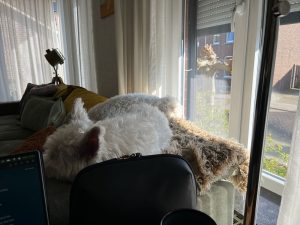Diving into Free-Writing Freedom
This week, I’ve decided to skip the usual thought processes that go into writing a weekly newsletter. Instead, I’m sitting writing this morning with a completely open mind. With no plans, no outline, and, most importantly, no worries.
I’ve minimised the editing process to help illustrate how free writing can produce seemingly unrelated thoughts mixed together. But I’m not worried; it’ll all come out in the wash.

My AI assistant suggests outlines, topics, or subtleties I hadn’t considered. The actual writing is all human me. The assistant also advises me when I’m being boring if I choose to listen.
See more articles, posts, and discussions about business, project management, Generative AI and Creative Writing on Medium here. If you have not already done so, subscribe to Medium. Or follow me here on Substack.
Side-Stepping Self-Doubt
I find it all too easy to feel stressed whenever I write; I constantly question myself. Self-doubt could be overwhelming if I allowed it to take hold, a not-uncommon problem for creatives.
There’s never any good reason to feel stressed about writing; either it’s good or it’s not. I don’t depend on writing to earn a living, although that’s an ambition. My writing for the last year has been about figuring out a process that works for me and balancing the time I spend with every other part of my busy life. I won’t repeat myself; I wrote an entire newsletter (or two) about this recently. But it is important to be aware of being happy and content.
Charting the Course: A Solopreneur Strategy for Life’s Many Hats
I’ve already discovered a minor problem when attempting to free-write. Fortunately, it’s easily resolved. I should never, ever read what I’ve just written, not yet, at least. I’ve found that the free-writing process is much easier if I only look at the keyboard and not the display. Then, I’m not thinking about the text, the syntax, or the coherence of the piece so much, and the words flow much more quickly.
I think that is why I can never get into journaling, either a digital journal or, heavens forbid, a handwritten diary. Writing then means I can’t help but see and reread what I’ve written. Then, the self-doubts, the urge to edit this or that line three paragraphs earlier and so on, impede the flow of writing down the textual translation of thought.
The Vomit Draft: Eliminating Pressure
This surprising free-writing discovery could also impact my long-form writing projects. The vomit or first draft can be written more quickly without any worries about the content’s quality, which comes later in the editing process. I wonder if this little mind trick is the push I’ve been searching for. I guess I’ll find out soon enough.
Then there’s also the time pressure of writing a weekly piece, the self-imposed deadlines, and the stress of other aspects of daily life, impacting any planned writing time. Perhaps this is another area that I need to think about. Every podcast, book, or course on writing, especially fiction writing, insists that we plan and follow through on fixed writing time every week.
I’ve tried that; again, I wrote about this subject a few weeks ago. Perhaps, for me, it isn’t the most productive path to follow. This is another thing to think about, not just yet. First, I want to hit my target word count or be close to it. A target is something I can live with and, in fact, quite enjoy. Glancing at the word count in Ulysses or Scrivener should be the only time I should pay attention to the display in the first draft process. But I need a bit of self-discipline to not glance through the previous paragraphs for today.
Being a Writer Doesn’t Have a Start Date
Taking Breaks and Enjoying Life
So, here I am, a gorgeous Friday morning, sitting at the small desk in our living room. The dogs are perched on the top of the sofa, basking in the sun and waiting for the excitement of seeing other dogs pass by in front of our house. At this point, they bark loudly, attempting to warn the other dogs away. After all, this is their street, and how dare these strangers invade their private space.

Here comes that time pressure again; I promised my wife we would go out for lunch today. I’m looking forward to it, too, as she has been away for two weeks and only got home later last night. After that, we’ll take a stroll in Maastricht, chill out, and enjoy the rare sunny day. But I’m not showered yet, and it’s getting late in the morning.
So, this is going to be another test. I’m pausing the writing for ten minutes or so. When I get back to the keyboard, will I be able to continue with the same mindset as now?
So, that was a 30-minute break. Guess what? Nothing has changed. I can still free-write, picking up where I left off.
Editing addendum on Saturday morning. I’m polishing up the piece; it’s almost ready to publish. The dogs, however, have other ideas. They’re in their usual spot and pushing me to go for a walk. I know it’ll do me good, and it’s another lovely morning. The point is not to fight it; that will guarantee the killing of any hope of creativity. Go with the flow. I would have sat in my office if I wanted peace and quiet. Ho hum.
The Minimal Toolset: Keeping It Super Simple
Over the past fourteen months, I have narrowed down my toolset for all forms of creative writing. The applications are simple and few. I use Ulysses for short-form writing, Scrivener for long-form writing projects, ChatGPT 4 for research suggestions for improvement and general feedback, and Grammarly to correct the most common mistakes.
For any AI naysayer, the tools I use are just that: tools. The creativity all comes from me. After all, no AI, no matter how large and performant, has my particular life experience. And, of course, an individual’s life experience is the source of all creativity.
There are a few annoying quirks that must be accepted and ignored. Grammarly hates the word ‘important’. It insists that it should be changed to essential or some other guff. But every time I use the word, Grammarly suggest I change it. Get over it already; when I write important, I mean important. Ok?
The hardware has also changed over the last year. It’s nothing complicated: an M2 13-inch MacBook Air paired with a Logitech MX Keys Mini Mechanical keyboard and a Logitech MX Master 3S. That’s it.
I tried swapping back to the laptop keyboard; it feels so unwieldy after the mechanical. Good for most things, but for me, my trusty mechanical keyboard is the bee’s knees.
I allowed myself to glance over today’s writing; the editing will be fun. I’ll be sure to add a section for the writing process summary at the end of the newsletter,
Enough for now; I’m off to lunch with my wife. 😉
An Unedited Glimpse into the Evolving Process
Bearing in mind that this is an ongoing experiment, the process I’ve used today can be broken down into a few distinct steps. Of course, this is short-form writing; I must try it out on my long-form writing projects.
- Few write to the target word count. For this piece, that was one thousand words.
- Run the entire text through Grammarly and accept the obvious corrections, but dismiss many suggestions. Important stays as important, for example.
- Editing can be a bit challenging when free writing is involved. The muse takes you from pillar to post and back again, so the paragraphs must be reorganised to ensure that the finished article reads as a coherent whole.
- Figure out, often with the help of ChatGPT, a good title, subtitle, and some decent section headers. I often find AI-generated suggestions okay but too generic for my tastes. Where they do help, though, is to give me better ideas and different approaches.
- Add images with honest captions and detailed alt-text.
- Add links to previous related newsletters.
- Publish
Final Thoughts
So, what was the subject of this week’s newsletter? Simply put, it’s about writing this newsletter and my writing process in general.
There are no tips; how could I be so presumptuous? Each writer’s process is, by nature, specific to the writer. Perhaps there are a few things I’ve talked about that may be worth experimenting with, but each to their own. There is no fast track to creating a process that sits perfectly for you, the unique writer. It takes time and a degree of self-awareness to figure out what works and what doesn’t.
Even though I write these newsletters primarily for myself, I know some do read them through. If you get this fare, please comment. I’m so curious to hear of the process variations of other creatives.
What do you do that is different? Likely everything. What’s your process? I’d love to start a conversation, so please leave a comment or two.
I apologise to my readers for some of the spellings you may feel are incorrect. I was born and brought up in the United Kingdom, and this is the spelling I am comfortable with (Grammarly is happy with it anyway).
